Jonas Kornprobst
Reliable Linearized Phase Retrieval for Near-Field Antenna Measurements with Truncated Measurement Surfaces
Sep 20, 2021



Abstract:Most methods tackling the phase retrieval problem of magnitude-only antenna measurements suffer from unrealistic sampling requirements, from unfeasible computational complexities, and, most severely, from the lacking reliability of nonlinear and nonconvex formulations. As an alternative, we propose a partially coherent (PC) multi-probe measurement technique and an associated linear reconstruction method which mitigate all these issues. Hence, reliable and accurate phase retrieval can be achieved in near-field far-field transformations (NFFFTs). In particular, we resolve the issues related to open measurement surfaces (as they may emerge in drone-based measurement setups) and we highlight the importance of considering the measurement setup and the phaseless NFFFT simultaneously. Specifically, the influence of special multi-probe arrangements on the reconstruction quality of PC solvers is shown.
Multi-Frequency Phase Retrieval for Antenna Measurements
May 20, 2021



Abstract:Phase retrieval problems in antenna measurements arise when a reference phase cannot be provided to all measurement locations. Phase retrieval algorithms require sufficiently many independent measurement samples of the radiated fields to be successful. Larger amounts of independent data may improve the reconstruction of the phase information from magnitude-only measurements. We show how the knowledge of relative phases among the spectral components of a modulated signal at the individual measurement locations may be employed to reconstruct the relative phases between different measurement locations at all frequencies. Projection matrices map the estimated phases onto the space of fields possibly generated by equivalent antenna under test (AUT) sources at all frequencies. In this way, the phase of the reconstructed solution is not only restricted by the measurement samples at one frequency, but by the samples at allfrequencies simultaneously. The proposed method can increase the amount of independent phase information even if all probes are located in the far field of the AUT.
* 14 pages, 29 figures, 1 table, published in IEEE Transactions on Antennas and Propagation
Compact Uniform Circular Quarter-Wavelength Monopole Antenna Arrays with Wideband Decoupling and Matching Networks
May 19, 2021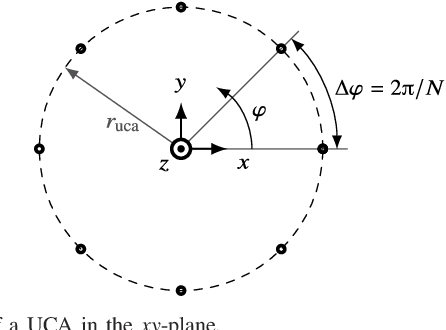
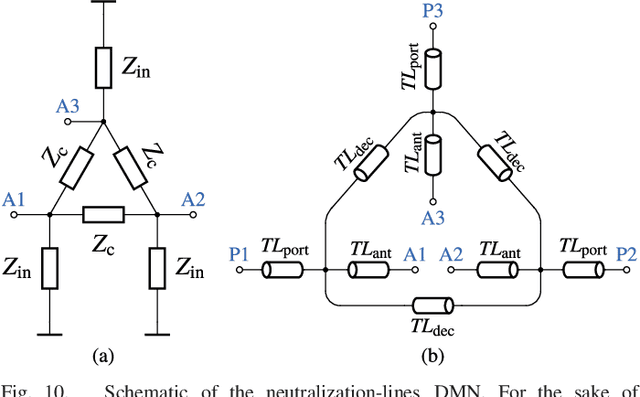
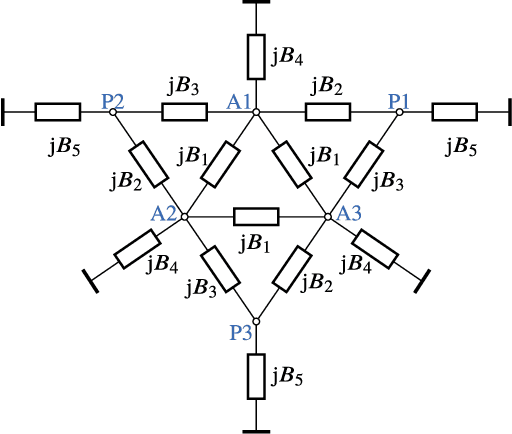
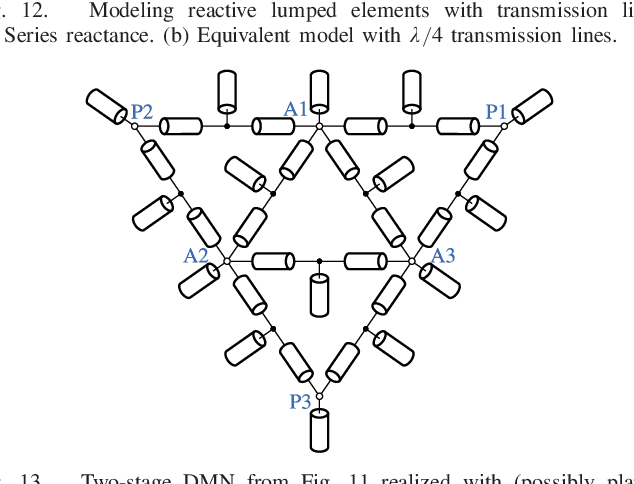
Abstract:Two novel decoupling and matching networks (DMNs) in microstrip technology for three-element uniform circular arrays (UCAs) are investigated and compared to a more conventional DMN approach with simple neutralization lines. The array elements are coaxially-fed quarter-wavelength monopole antennas over a finite groundplane. Three-element arrays are considered since UCAs with an odd number of elements are able to provide an almost constant maximum array factor over the whole azimuthal angular range. The new designs are explained from a theoretical point of view and their implementations are compared to four- and three-elements UCAs without DMN in terms of decoupling and matching bandwidth as well as beamforming capabilities. In addition to excellent decoupling and matching below -16 dB, a broader bandwidth is obtained by the two DMNs. The reasons for the enhanced bandwidth are similar in both cases: By introducing several circuit elements offering additional degrees of freedom, matching of the monopole input impedances at different frequencies becomes feasible. One of the presented designs offers a larger bandwidth, while the other design is able to provide a better total efficiency. Scattering parameters, radiation patterns, beamforming capabilities, and enhanced gain are all verified by measurements over the operating bandwidth.
* 15 pages, 28 figures, 1 table, published in IEEE Transactions on Antennas and Propagation
A Millimeter-Wave Self-Mixing Array with Large Gain and Wide Angular Receiving Range
May 18, 2021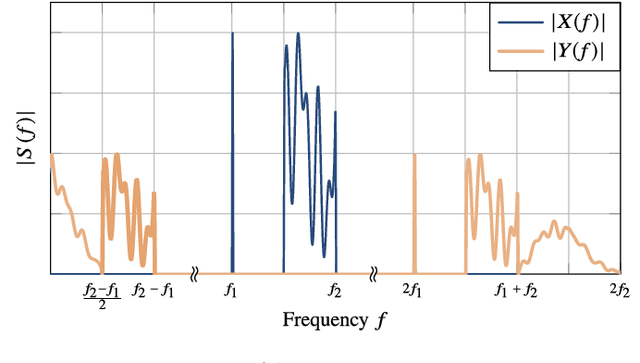
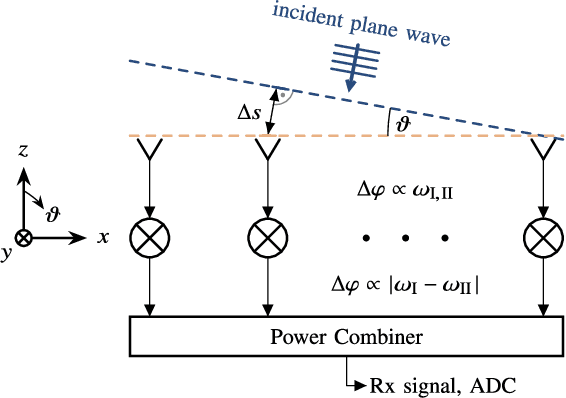


Abstract:The concept of self-mixing antenna arrays is presented and analyzed with respect to its beneficial behavior of large gain over a wide angular range. The large gain is attained by an antenna array with large element spacing, where all array element signals are combined approximately coherently over the entire angular receiving range. This functionality is achieved by the self-mixing principle, where an exact description via an intermediate frequency (IF) array factor is derived. For verification purposes, a 4 x 2 self-mixing array is fabricated and measured in the frequency range from 34 GHz to 39 GHz. A multiple-resonances millimeter-wave microstrip patch antenna has been especially developed to achieve large bandwidth and a wide angular receiving range. The broad beamwidth is achieved by two parasitic patches and suitable radiation characteristics of the resonant modes. The self-mixing of the receive signal is realized at each antenna element by a Schottky diode with an optimized operating point. The down-converted array element signals are then combined and measured at the IF. The receive power is increased significantly over a large angular range as compared to conventional array feeding techniques. The simulation results are verified by measurements, which show very good agreement.
* 10 pages, 15 figures, published in IEEE Transactions on Antennas and Propagation
A mm-Wave Patch Antenna with Broad Bandwidth and a Wide Angular Range
May 17, 2021



Abstract:A novel mm-wave microstrip-fed patch antenna with broad bandwidth and wide angular coverage suitable for integration in planar arrays is designed, analyzed and verified by measurements. The antenna provides a bandwidth of 13.1% between 34.1 GHz and 38.9 GHz, which is achieved by a slotted multiple resonances microstrip patch and a matching circuit in microstrip technology. The antenna is built on RO3003 substrate with top and ground layers, which is low cost compared to other techniques. For simple integration with microstrip and frontend circuits, the feeding happens in the top layer with a microstrip coupling gap feed. The wide half power beamwidth is achieved by suitably designed parasitic patches for the first resonant mode. The second resonant mode has a wide half power beamwidth by default. The half power beamwidth is between 100{\deg} and 125{\deg} within the matched bandwidth, which is a very good value for a microstrip patch antenna radiating over a ground plane. The measured input impedance and radiation characteristic show very good agreement with simulation results.
* 6 pages, 11 figures, 1 table, published in IEEE Transactions on Antennas and Propagation
 Add to Chrome
Add to Chrome Add to Firefox
Add to Firefox Add to Edge
Add to Edge